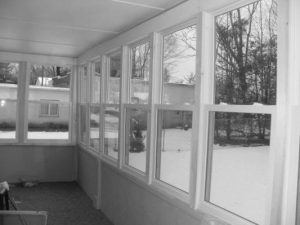 If you own, sell or manage rental properties, you probably spend a good portion of your time and budget dealing with ongoing maintenance issues. As frustrating as that may be at times, maintaining the physical property in good working order is crucial to the long-term success of any rental investment.
If you own, sell or manage rental properties, you probably spend a good portion of your time and budget dealing with ongoing maintenance issues. As frustrating as that may be at times, maintaining the physical property in good working order is crucial to the long-term success of any rental investment.
We all recognize the importance of completing routine maintenance chores, such as cleaning, painting, mechanical upkeep and landscaping. I want to address an equally important, but often overlooked aspect of rental-property maintenance: storm windows.
Now, you may be thinking that storm windows went out with the Nixon administration, but that’s not so. Even with the advent of insulated glass windows, modern storm windows can play a key role in protecting your rental property and investment.
For the uninitiated, a storm window is a secondary window that’s installed directly over an existing window. Its main purpose is to block out cold winter winds. Storm windows are typically installed each fall and removed each spring.
A storm window consists of a perimeter frame and two operable sash, which can be raised or lowered, much like a standard double-hung window. Insect screens are also available.
Here’s a brief look at some of the many benefits of storm windows:
Energy Efficient
Properly installed storm windows can dramatically reduce heating costs by blocking out cold drafts and sealing in heated air. They’re particularly effective on buildings with older windows, which tend to be a bit drafty. As a side benefit, the furnace won’t have to work as hard to maintain a constant room temperature, so it’ll likely last longer and need fewer repairs.
Very Low-Maintenance
Storm windows are typically made of aluminum or vinyl. Both materials are lightweight, durable and extremely weather resistant. Neither aluminum nor vinyl will rot or crack, and both can be power washed or scrubbed cleaned with no ill effects.
Added Protection
When a storm window is installed over an existing window, it protects that window from a myriad of destructive forces, including rain, snow, sleet, dust, dirt, birds and insects. This is particularly important if the building has painted wood windows, which are much more susceptible to exposure to the elements. Some storm windows even meet stringent hurricane protection standards.
Increased Security
Storm windows, when closed and locked, add an extra layer of safety and security to the building. When confronted by a storm window, most burglars will move on to a softer target rather than try to force their way past two windows.
Economical
The benefits of storm windows far outweigh the initial purchase price, especially when you consider that a quality-built storm window can last 20 years or more, if it’s properly handled and stored. It’s hard to say exactly how much a storm window costs since so much depends on the window’s size, type and manufacturer, but expect to pay between $60 and $80 for a 36- by 55-inch aluminum storm window.
A Replacement Alternative
If you’re considering replacing the windows in your rental property, storm windows might offer a quicker, more affordable option. Many of today’s high-quality storm windows have technological advancements that provide similar results to new window replacement at a fraction of the cost.
For example, Larson’s Premium or Performance Series Storm Windows can be ordered with super energy-efficient Low-E glass, which keeps rooms cooler in summer and warmer in winter. These types of high-performance storm window have proven so effective that the Department of Energy recently established an Energy Star program to recognize the benefits of Low-E storm windows. Of course, you should only consider storm windows over total replacement if the building’s windows are in good working order and free of any major defects.
Installation Tips
 There are two basic ways to attach a storm window: inside mount or outside mount. With an inside mount, also called a blindstop mount, the storm window fits in between the brick mold and sits flat against the main window’s jambs. This type of installation looks better, but requires a very precise-fit storm window. There should be only 1/8 inch of clearance around the perimeter of the storm window.
There are two basic ways to attach a storm window: inside mount or outside mount. With an inside mount, also called a blindstop mount, the storm window fits in between the brick mold and sits flat against the main window’s jambs. This type of installation looks better, but requires a very precise-fit storm window. There should be only 1/8 inch of clearance around the perimeter of the storm window.
With an outside mount, also called an overlap installation, the storm window overlaps the main window and is screwed directly to the brick mold. In this situation, the exact size of the storm window is a little less critical, as long as it fits against the brick mold. It should overlap onto the brick mold by ½ to ¾ inch on all sides.
As mentioned earlier, storm windows are usually installed right before the weather turns cold.
Here are a few other installation tips:
- After removing the storm windows from storage, use a damp cloth to wipe them clean of all dust and dirt. Use a wet/dry vacuum to clean the screens.
- A brand-new storm window will have a plastic band wrapped around its center, which prevents the window frame from bowing out of shape. Don’t remove this band until the storm window is securely screwed in place.
- Apply latex caulk along the horizontal top and vertical sides of the main window. Don’t caulk the bottom sill; condensation and moisture needs a place to drain out. Caulking storm windows is recommended because it helps seal out cold drafts and wind-driven rain. However, it does create a maintenance issue: When you remove the storm windows in the spring, you’ll need to scrape off the old caulk.
- Hold the storm window in place centered over the main window. Use a level to ensure the storm is plumb (vertical) and level (horizontal). Fasten it with the recommended screws.
- Be careful not to overtighten the mounting screws or you’ll crush or deform the storm window’s mounting flange. Drive in the screws with a cordless impact driver, which offers much better screwdriving control than a cordless drill/driver. Use a damp cloth to wipe away any excess caulk that squeezes out from behind the storm window.
- Immediately after installation, go inside the building and check the operation of the storm window. Confirm that both sash open and close smoothly and lock securely.
Most manufacturers and home improvement stores also offer storm window installation services if you aren’t adept at DIY or simply want to skip the hassle. Either way, adding storm windows to your property will greatly improve its efficiency.
 Author Bio – Joseph Truini
Author Bio – Joseph Truini
As a home improvement expert and author of the best-selling book “Building a Shed,” Joseph Truini provides great how-to advice on a huge range of topics, including installing storm windows. If you are considering installing storm windows in your home or rental property, visit The Home Depot to view your options.







It’s good to remember that storm windows are a protection against thieves as well as the elements. My wife wants to install storm windows on our home this year so we can save energy and avoid broken glass. Considering that it would also deter people from breaking into our home makes us feel more confident about investing in them.
Good thoughts, Oscar!